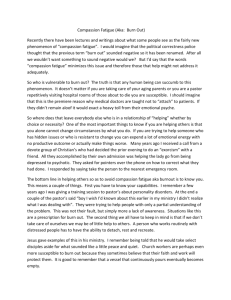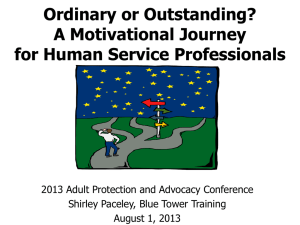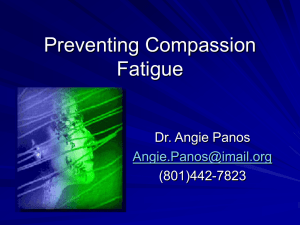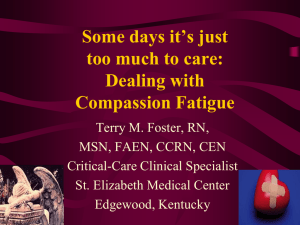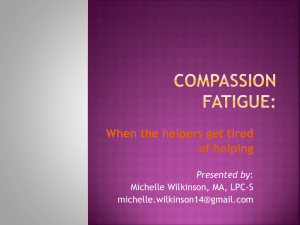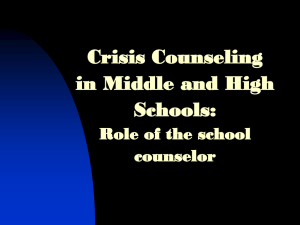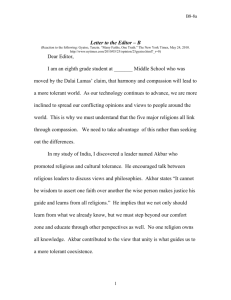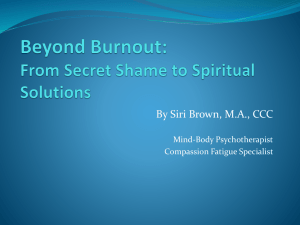Compassion Fatigue content outline template
advertisement
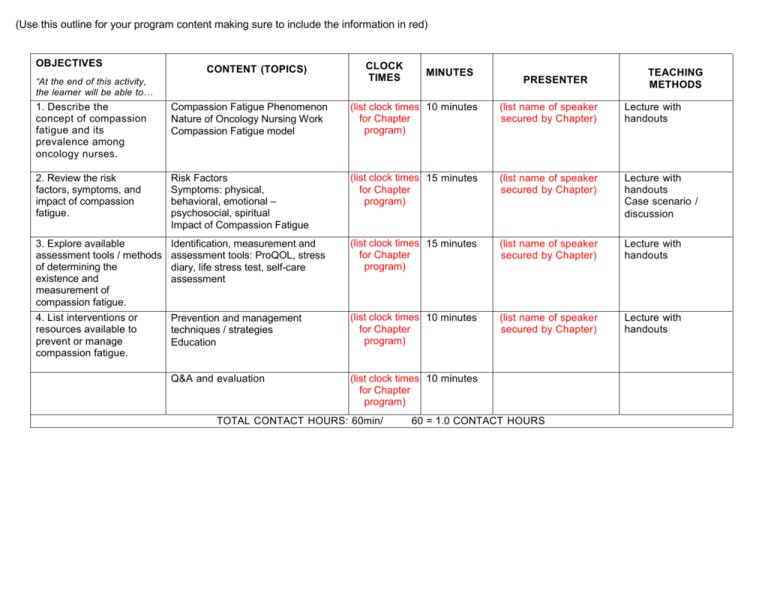
(Use this outline for your program content making sure to include the information in red) OBJECTIVES CONTENT (TOPICS) “At the end of this activity, the learner will be able to… CLOCK TIMES MINUTES PRESENTER TEACHING METHODS 1. Describe the concept of compassion fatigue and its prevalence among oncology nurses. Compassion Fatigue Phenomenon Nature of Oncology Nursing Work Compassion Fatigue model (list clock times 10 minutes for Chapter program) (list name of speaker secured by Chapter) Lecture with handouts 2. Review the risk factors, symptoms, and impact of compassion fatigue. Risk Factors Symptoms: physical, behavioral, emotional – psychosocial, spiritual Impact of Compassion Fatigue (list clock times 15 minutes for Chapter program) (list name of speaker secured by Chapter) Lecture with handouts Case scenario / discussion 3. Explore available assessment tools / methods of determining the existence and measurement of compassion fatigue. Identification, measurement and assessment tools: ProQOL, stress diary, life stress test, self-care assessment (list clock times 15 minutes for Chapter program) (list name of speaker secured by Chapter) Lecture with handouts 4. List interventions or resources available to prevent or manage compassion fatigue. Prevention and management techniques / strategies Education (list clock times 10 minutes for Chapter program) (list name of speaker secured by Chapter) Lecture with handouts Q&A and evaluation (list clock times 10 minutes for Chapter program) TOTAL CONTACT HOURS: 60min/ 60 = 1.0 CONTACT HOURS References Aycock , N., & Boyle, D. (2009). Interventions to manage compassion fatigue in oncology nursing. Clinical Journal of Oncology Nursing, 13 (2), 183-191. Barnard, D., Street, A., & Love, A.W. (2006). Relationships between stressors, work supports, and burnout among cancer nurses. Cancer Nursing, 29 (4), 338-345. Buerhaus, P., Donelan, K., DesRoches, C., Lamkin, L., & Mallory, G. (2001). State of the oncology nursing workforce: Problems and implications for strengthening the future. Nursing Economics, 19: 198-208. Boyle, D. (Jan 31, 2011) “Countering compassion fatigue: a requisite nursing agenda” OJIN: The Online Journal of Issues in Nursing Vol. 16, No. 1, Manuscript 2. Boyle, D. (March 4, 2013) “Oncology Nurse Compassion Fatigue” The Puget Sound Chapter of the Oncology Nursing Society. Bush, N.J. (2009). Compassion fatigue: Are you at risk? Oncology Nursing Forum, 36(1), 24-28. Coetzee, S.K., & Klopper, H.C. (2009). Compassion fatigue within nursing practice: A concept analysis. Nursing and Health Sciences, 12, 235-243. “Compassion and fatigue.” Truthaboutnursing.com. 3 Jan. 2012. Web. 1 July 2013. Compassion Fatigue Awareness Project. Compassionfatigue.org. Web. 21 June 2013. Emanuel, L., Ferris, F.D., von Gunten, C.F., & Von Roenn, J.H. (June 6, 2011) “Combating compassion fatigue and burnout in cancer care.” Medscape. Figley, C. (1995). Compassion fatigue: Coping with secondary traumatic stress discorder in those who treat the traumatized. New York: BrunnerRoutledge. Figley, C.R. (2002). Treating compassion fatigue. New York, NY: BrunnerRoutledge. Fletcher, S. (November 30, 2010) “Five strategies to cope with compassion fatigue.” NursingLink. Scrubs Magazine. Web. 21 June 2013. Gentry, J.E., Baggerly, J., & Barnowsky, A. (2004). Training as treatment: effectiveness of the certified compassion fatigue specialist training. The International Journal of Emergency Mental Health, 6(3),147-155. Hughes, D. (April 26, 2013) “’Day of Rejuvenation’ helps Combat Compassion Fatigue.” OncologyNurseAdvisor. Web. 1 July 2013. Joinson. C. (1992). Coping with compassion fatigue. Nursing, 22(4), 116, 188-119, 120. Kraybill, K., 2003. “Creating and maintaining a healthy work environment: a resource guide for staff retreats.” National Health Care for the Homeless Council. October 2011. Web. 1 July 2013. Lowenstein, T. “Life Stess Test.” Stressmarket. DBA Stress Market, Inc. , n.d. Web. 21 June 2013. Objective(s) this reference relates to Objectives 3, 4 Objectives 1,2 Objectives 1, 2 Objectives 1, 2, 3, 4 Objectives 1, 2, 3, 4 Objectives 1, 2, 3 Objectives 2, 3 Objectives 1, 2, 3 Objectives 1, 2, 3, 4 Objectives 1, 2, 3, 4 Objectives 1, 2, 3, 4 Objectives 1, 3, 4 Objectives 1, 3, 4 Objectives 1, 2, 3, 4 Objectives 3, 4 Objectives 1, 2, 3, 4 Objective 4 Objective 3 Maslach, C., Schaufeli, W.B., & Leiter, M.P. (2001). Job burnout. Annual Review of Psychology, 52:397-422. Mathieu, F. (2007). “Transforming Compassion Fatigue into Compassion Satisfaction: Top 12 Self-care tips for helpers” Workshops for the Helping Professions. 1-7. McSteen, K. (2010). “Compassion fatigue in oncology nursing: A witness to suffering.” Oncology Nurse Advisor October 2010, 17-22. Medland, J., Howard-Ruben, J., & Whitaker, E (2004). Fostering psychosocial wellness in oncology nurses: Addressing burnout and social support in the workplace. Oncology Nursing Forum, 31(1), 47-54. Moya del Pino, B. (July 24, 2012). “Special Issue: Oncology NursingEmotional rescue: Addressing compassion fatigue in oncology nursing.” National Cancer Institute,9 (15). Najjar, N., Davis, L.W., Beck-Coon, K., & Doebbeling, C. C. (2009). Compassion fatigue: a review of the research to date and relevance in cancer-care providers. Journal of Health Psychology, 14 (2), 267-277. Pfifferling, J.H., & Gilley, K. (2000). Overcoming compassion fatigue. Family Practice Management,7 (4), 39-46. Portnoy, D. (n.d.) Self care for clinicians. Psy Broadcasting Corporation. 1-20. Potter, P., Deshields, T., Divanbeigi, J., Berger, J., Cipriano, D., Norris, L., & Olsen, S. (2010). Compassion fatigue and burnout: Prevalence among oncology nurses. Clinical Journal of Oncology Nursing, 14(5), E56-E62. Radziewicz, R.M. (2001). Self-care for the caregiver. Nursing Clinics of North America, 36(4), 855-869. Ruff-King, M. (n.d.). “Compassion fatigue in nursing”. nursesusa.org. Web. 1 July 2013. Saakvitne, K.W., & Pearlman, L.A. (1996). Transforming the pain: a workbook on vicarious traumatization. New York, NY: Norton Professional Books. Sabo, B.M. (2006). Compassion fatigue and nursing work: Can we accurately capture the consequences of caring work? International Journal of Nursing Practice, 12(3), 136-142. Sabo, B., (Jan 31, 2011) “Reflecting on the concept of compassion fatigue” OJIN: The Online Journal of Issues in Nursing Vol. 16, No. 1, Manuscript 1. Schuster, J. L. “With nurses at risk of compassion fatigue, hospitals try to ease their stress.” Washington Post. 10 June 2013. Web. 1 July 2013. “See how easily you can prevent compassion fatigue in nursing”. nursetogether.com. Web.1 July 2013. Stamm, B.H. (2009). Professional quality of life: Compassion satisfaction and fatigue. Version 5 (ProQOL). Available at: www.proqol.org. “Six ways nurses can beat compassion fatigue.” NursingLink. 26 June 2009. Web. 1 July 2013. “Stress Diaries: Identifying causes of short-term stress.” Mind Tools. Mind Objectives 1, 2, 3, 4 Objectives 1, 2, 3, 4 Objectives 1, 2, 3, 4 Objectives 1, 2, 3, 4 Objectives 1, 2, 3, 4 Objectives 3, 4 Objectives 3, 4 Objectives 3, 4 Objectives 1, 2, 3, 4 Objective 3 Objectives 1, 2, 3, 4 Objectives 3, 4 Objectives 1, 2, 3, 4 Objectives 1, 2, 3, 4 Objectives 3, 4 Objectives 1, 2, 3, 4 Objectives 3 Objectives 1, 2, 3, 4 Objective 3 Tools, Ltd., n.d. Web. 4 July 2013. “Tea for the Soul” Los Angelos Sentinel. 25 Feb. 2011. Web. 1 July 2013. Vahey, D.C., Aiken, L.H., Sloane, D.M., Clarke, S.P., & Vargas, D. (2004). Nurse burnout and patient satisfaction. Medical Care, 42 (2, Suppl.), 11571166. Walton, A.M., & Alvarez, M. (2010). Imagine: Compassion fatigue training for nurses. Clinical Journal of Oncology Nursing. 14(4), 399-400. Yoder, E.A. (2010). Compassion fatigue in nurses. Applied Nursing Research, 23 (4), 191-197 Objective 4 Objectives 1, 2 Objectives 1, 2, 3, 4 Objectives 1, 2, 3, 4 Format for evidence-based sources: Journal article: Authors, year of publication, article title, journal title, volume/number, pages. Book chapter: Chapter author, chapter title, year published, book authors, book title, chapter pages, publisher. Website: Article/content author, article title, year of publication (if available), website URL and date last retrieved article. Clinical guidelines: Author, year of publication, guideline title. Expert resource: Name of resource and descriptive information (eg, credentials and description of expertise on topic, description of organization and expertise in topic)
